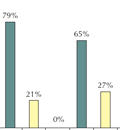The eLitMed.hu medical portal uses computer cookies for convenient operation. Detailed information can be found in the Cookie-policy.
Lege Artis Medicinae - 2004;14(07)
Content
[ENDOTHELIUM PROTECTION IN HYPERTENSIVE PATIENTS]
[The author presents a review about the fundamental principles of normal endothelial function and the main causes for the development of endothelial dysfunction. First of all, endothelial dysfunction results in structural alterations in the wall of the vessel - the „vascular remodelling” in hypertension - and that is the base of hypertensive microangiopathy and target organ damage. In patients with high blood pressure the reactivity of vessels is impaired by the endothelial dysfunction. The members of the main drug groups can influence the vasoactive factors produced in endothelium differently. This different effects of drugs create different clinical benefits. Especially, the ACE inhibitors, the calcium antagonists (mostly the new generation of dihydropyridines) have endothelial protective effects, but some β-blockers, α-1 adrenergic blockers and - in a totally different way of action - the statins are capable of influencing the endothelial dysfunction.]
[PHARMACOLOGICAL TREATMENT OF URINARY INCONTINENCE]
[One of the forms of conservative treatment of incontinent patients is pharmacological therapy. The choice of medicine for the conservative treatment of an incontinent patient is based on the diagnosis formulated by applying the appropriate diagnostic procedures. As far as pharmacological treatment is concerned, it is for the treatment of incontinence caused by idiopathic and neurogenic involuntary detrusor contraction. There are medicines for everyday clinical practice, partly uroselective ones with mainly anticholinergic effects. In case of stress incontinence the reduction of the symptoms can be expected by using an agent that increases the tone of the closing muscle of the urethra. In overflow incontinence the aim of the pharmacological treatment is to reduce the overflow resistance.]
[FIRST EXPERIENCES WITH INFLIXIMAB THERAPY IN CROHN’S DISEASE - RESULTS OF A HUNGARIAN MULTICENTRE STUDY]
[INTRODUCTION - In recent years a number of clinical trials have been proved that infliximab, a monoclonal chimeric antibody against tumour necrosis factor (one of the proinflammatory cytokines) is an effective induction and maintenance therapy in severe and fistulizing Crohn’s disease. The authors summarize the results of the first Hungarian, open, multicenter clinical trial with biological treatment of Crohn’s disease. PATIENTS AND METHODS - Overall 74 patients in 9 study-centers were enrolled and allocated into the following two groups: 29 patients (31%) with severe, active, therapy-resistent clinical picture of Crohn’s disease and 45 individuals (61%) showing fistulizing forms of the disease. Infliximab was administered iv. in a dose of 5 mg/kg body mass one single occasion in patients formed the first group and altogether three times in cases suffering of fistulizing form of the disease. RESULTS - In active Crohn cases infliximab exerted its beneficial effect within 4 weeks (58% of patients improved) which was most pronounced at week 8th (79% of the patients was in better condition). However, in cases of fistulizing form longer period is neccessary for developing the effect. In 76% of treated patients proved to be efficacious within 14 weeks but later on flare-ups were observed. Concomittantly administered immunsuppressive agents did not altered the beneficial effect of infliximab. CONCLUSIONS - The results are proving the benefit of infliximab induction therapy both in cases of severe, active or in fistulizing forms of the disease. The article reviews the indication of infliximab treatment and provides a „user’s guide” for practizing clinicians.]
[LATE COMPLICATION OF EXTRANODAL LYMPHOMA FOLLOWING DERMATOMYOSITIS]
[INTRODUCTION - Intramuscular follicular Bcell lymphoma is a rare entity of malignant lymphomas complicating the disease course of dermato/polymyositis. CASE REPORT - The authors report a female patient who was diagnosed with dermatomyositis in 1963 (age of 36). She was given steroid and hydroxychloroquine therapy. In 1973 she was treated with steroid for Boeck sarcoidosis. In 1999, she was treated for steroid therapy again for reoccurence of dermatomyositis. In 2000, a histological diagnosis of primary intramuscular follicular lymphoma was established from the right thigh region. She was given several courses of polychemotherapy and radiation therapy, but the lymphoma was difficult to control, and she died of progressive disease in 2003. CONCLUSION - It is an interesting case as 37 years elapsed since the diagnosis of dermatomyositis before the lymphoma has started. We could not state a definite relation between the myositis and the lymphoma but the increased frequency of autoimmune diseases is probably due to immune regulatory problems, that have eventually led to the appearance of the rapidly growing indolent lymphoma.]
[THE GENETICS OF DIABETES MELLITUS]
[The number of diabetic patients will be doubled in the coming decades reaching 300 million for year 2025. The number of type 1 diabetics will also be increased but the majority of it will result from the increased number of type 2 diabetics. All types of diabetes are the consequence of a combination of genetic susceptibility and environmental factors, meaning that the prevention of diabetes epidemic cannot be done without the clarification of the genetic background. Significant progression has happened in the discovery of the genetic background of type 1 diabetes mellitus. It was helped by the etiologic classification of the disease: with the new classification the patient groups became more homogeneous. The HLA system is responsible for about 50-70% of the genetic risk while the effects of other genetic factors contribute 1-2% of the genetic susceptibility, respectively. Presently 25 gene regions are known as the different genetic factors of type 1 diabetes mellitus. Regarding the HLA system, the genes and pathomechanism causing the disease are not known. The classification of diabetes mellitus can be based on the HLA type while the predictability of type 1 diabetes mellitus is helped by the HLA type and the INS-VNTR. Much less is known about the genetic background of the polygenic type 2 diabetes mellitus. Its manifestation is now happening at younger age before. The best-fit genetic model consists of only a few genes with moderate effect superimposed on a polygenic background. Several „candidate” genes participating in the impaired insulin secretion and insulin action have already been investigated as the genes responsible for type 2 diabetes. These data showed the specificity in the population and most showed mild or modest association with the disease. Genomewide scans have resulted a number of significant diabetes susceptibility genes specific for a variety of populations, but these investigations have only resulted in the isolation of one gene (calpain 10) that is thought to contribute to type 2 diabetes. Most recent genomewide scans found loci on chromosome 20 in two different populations with significant segregation of type 2 diabetes. These loci are near to the region harboring the transcription factor hepatocyte nuclear factor genes. The transcription regulator HNF family is responsible for the regulation of the expression of several genes participating in the function of liver and pancreatic islet becoming a strong candidate for being a diabetes gene.]
[THE PSYCHO-SOCIAL BACKGROUND FACTORS OF INDUCED ABORTIONS BASED ON A REPRESENTATIVE NATIONAL SURVEY]
[INTRODUCTION - In Hungary the number of induced abortions is three times higher than in European Union countries. The exploration of the bio-psycho-social factors in the background of abortions may serve as an instrument to develop effective prevention. METHODS - The Hungarostudy 2002 national representative study included 12,634 interviewed subjects. The sample represents the Hungarian population above the age of 18, according to gender, age and geographical location. The aim of the health survey was to analyse the physical and psychological status of the Hungarian population as well as the psychosocial risk factors. The prevalence of abortion in the female sub-sample was 22%. We analysed the background factors of abortion with the help of a statistical analysis. RESULTS - The risk factors behind abortions can be grouped as: physical abuse on behalf of partners and/or parents, attachment disorder and early traumatisation, lack of social support, low financial status and inadequate social environment. These factors have all shown significant connection to abortions. Suicide attempts and suicidal thoughts, high Beck Depression (BDI) scores, smoking and alcohol consumption are also significant among those who had abortions. CONCLUSION - An important aim of the Hungarostudy 2002 survey and the follow-ups is to serve a more extensive and effective prevention by exploring the background factors of induced abortions.]
1.
Clinical Neuroscience
[Headache registry in Szeged: Experiences regarding to migraine patients]2.
Clinical Neuroscience
[The new target population of stroke awareness campaign: Kindergarten students ]3.
Clinical Neuroscience
Is there any difference in mortality rates of atrial fibrillation detected before or after ischemic stroke?4.
Clinical Neuroscience
Factors influencing the level of stigma in Parkinson’s disease in western Turkey5.
Clinical Neuroscience
[The effects of demographic and clinical factors on the severity of poststroke aphasia]1.
2.
3.
4.
5.












